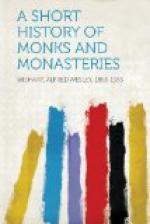Two years after the event just described Francis was carried on a cot outside the walls of Assisi, where, lifting his hands he blessed his native city. Some few days later, on October 4, 1226, he passed away, exclaiming, “Welcome, Sister Death!”
Whatever we may think of the legends that cluster about his life, Francis himself must not be held responsible for all that has been written about him. He himself was no phantom or mythical being, but a real, earnest man who, according to his light, tried to serve his generation. As he himself said: “A man is just so much and no more as he is in the sight of God.” “Francis appears to me,” says Forsyth, “a genuine, original hero, independent, magnanimous, incorruptible. His powers seemed designed to regenerate society; but taking a wrong direction, they sank men into beggars.” Through the mist of tradition the holy beggar and saintly hero shines forth as a loving, gentle soul, unkind to none but himself. However his biography may be regarded, his life illustrates the beauty and power of voluntary renunciation,—the fountain not only of religion but of all true nobility of character. He may have been ignorant, perhaps grossly so, as Mosheim thinks, but nevertheless he merits our highest praise for striving honestly to keep his vow of poverty in the days when worldly monks disgraced their sacred profession by greed, ambition, and lustful indulgence.
The Franciscan Orders
The orders which Francis founded were of three classes:
1. Franciscan Friars or Order of Friars Minor, called also Gray or Begging Friars. The year in which Francis took the habit, 1208, is reckoned the first year of the order, but the Rule was not given until 1210.
This Rule, which has not been preserved, was very simple, and doubtless consisted of a group of gospel passages, bearing on the vow of poverty, together with a few precepts about the occupations of the brethren. The pope was not asked to sanction the Rule but only to give his approbation to the missions of the little band. Some of the cardinals expressed their doubts about the mode of life provided for in the rules. “But,” replied Giovanni di San Paolo, “if we hold that to observe gospel perfection and make profession of it is an irrational and impossible innovation, are we not convicted of blasphemy against Christ, the Author of the Gospel?”
There was also the Rule of 1221, which makes an intermediate stage between the first Rule and that which was approved by the pope November 29, 1223. The Rule of 1210 was thoroughly Franciscan. It was the expression of the passionate, fervent soul of Francis. It was the cry of the human heart for God and purity. The Rule of 1223 shows that the church had begun to direct the movement. Sabatier says of these two rules: “At the bottom of it all is the antinome of law and love. Under the reign of law we are the mercenaries of God, bound down to an irksome task,




